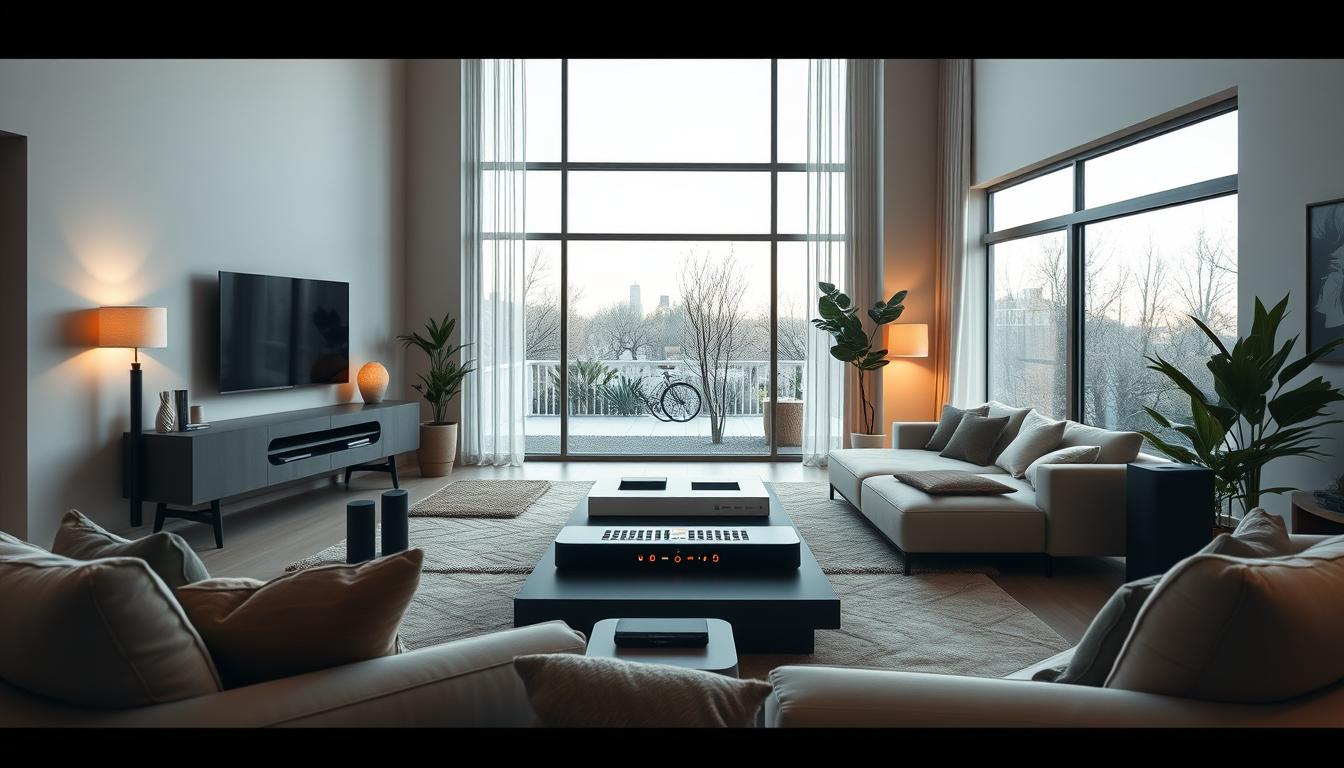Welcome to my guide on setting up a smart home hub. I’ll show you how to make your home smart. Smart home technology is getting more popular, making it simple to smartify your home.
A smart home hub connects all your smart devices. This lets you control and automate them easily. In this article, I’ll give you a detailed guide to setting up a smart home hub.
I’ll cover everything from picking the right smart home hub to customizing settings. This will help you easily create a connected home with smart devices and automation.
What is a Smart Home Hub?
A smart home hub is the heart of your smart home system. It lets you control all your devices from one spot. You can turn on lights, adjust the thermostat, and watch security cameras with just your voice or a tap on your phone. This works because different devices talk to each other smoothly.
Setting up a smart home can seem hard, but the right hub makes it easy. A good hub connects to lights, thermostats, cameras, and locks. It also works with popular virtual assistants like Amazon Alexa or Google Assistant.
Definition and Purpose
A smart home hub connects all your smart devices. It lets you control and automate them easily. Its main job is to give you a central way to manage and watch your devices.
How it Benefits Your Home
A smart home hub can do a lot for your home. It can save energy by turning off lights and appliances when you’re not using them. It also makes your home safer by letting you watch security cameras and get alerts when there’s movement.
Common Features to Look For
When picking a smart home hub, look for certain features. These include:
- Compatibility with various devices and virtual assistants
- Easy setup and installation
- User-friendly interface
- Advanced automation features
- Security and data protection
By looking for these features, you can find a hub that fits your needs. It will give you a smooth smart home experience.
Choosing the Right Smart Home Hub
Choosing the right smart home hub can be tough. You need to think about how many devices you want to connect. Also, consider how much automation you need and if it works with your current devices. Brands like Samsung, Apple, and Google have many options with different features and prices.
Voice control is key when picking a smart home hub. Many hubs let you control devices with your voice. Smart home apps are also important for managing your devices and automating tasks. Some top smart home hubs include:
- Samsung SmartThings Hub
- Apple HomePod
- Google Home Hub
These hubs offer features like working with many devices, voice control, and apps. By looking at what you need and comparing hubs, you can choose the best one. This will help you create a smooth smart home experience.
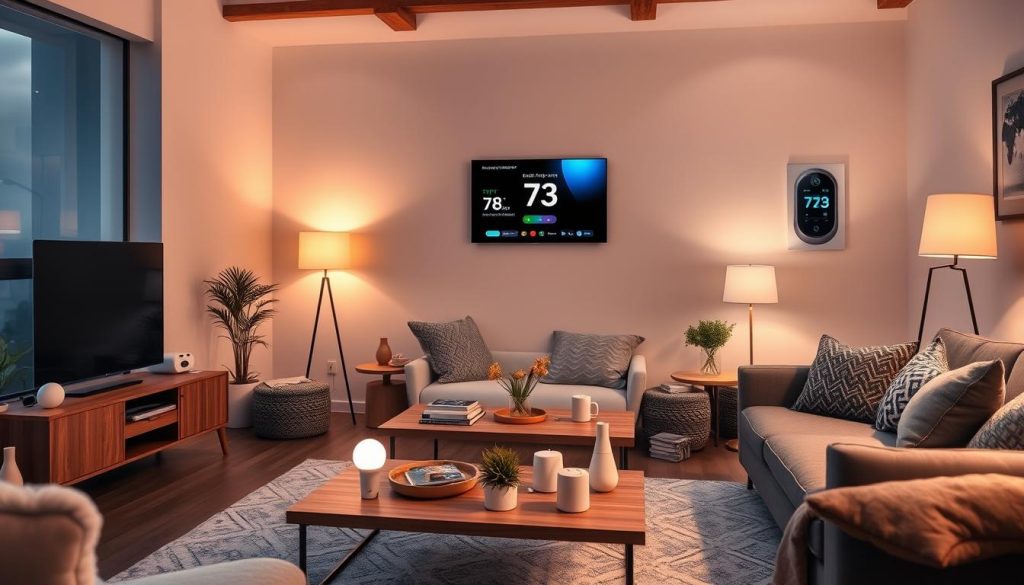
| Smart Home Hub | Compatibility | Voice Control | Price |
|---|---|---|---|
| Samsung SmartThings Hub | Wide range of devices | Integrated voice control | $70-$100 |
| Apple HomePod | Apple devices only | Siri voice control | $300-$400 |
| Google Home Hub | Google devices only | Google Assistant voice control | $100-$200 |
Preparing for Your Smart Home Hub Setup
Starting your smart home journey? First, get your home and devices ready for your smart home hub. A strong internet connection is key for your hub to work well. This is where the internet of things plays a big role, connecting and controlling all your devices.
Organizing your smart devices is crucial. Sort them out and plan how you’ll use them. This makes your smart home experience smooth and integrated. Think about which devices you’ll connect, like lights, thermostats, and security cameras, and how you’ll control them.
Assessing Internet Connectivity
Check your internet speed and reliability. Use online tools to test your speed and find ways to improve. Aim for at least 10 Mbps for your smart devices.
Organizing Your Smart Devices
Make a list of your smart devices and group them by type and function. This helps you plan how to use them and check if they work with your hub.
Creating a Smart Home Strategy
Think about what you want from your smart home. Do you want to save energy, boost security, or make life easier? Plan your goals and how to reach them. This will help you get the most from your smart home setup.
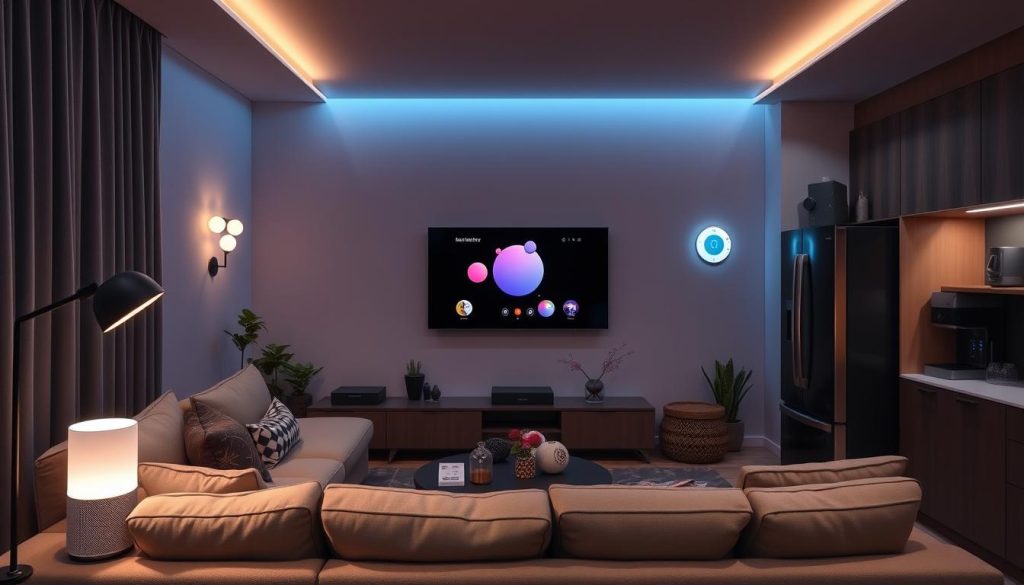
By following these steps, you’ll set up your smart home hub smoothly. Always follow the manufacturer’s instructions and be careful when setting up your devices.
| Device Type | Function | Compatibility |
|---|---|---|
| Light Bulbs | Smart Lighting | Wi-Fi, Bluetooth |
| Thermostats | Temperature Control | Wi-Fi, Zigbee |
| Security Cameras | Home Security | Wi-Fi, Ethernet |
Unboxing and Inventory
When you get your smart home hub, it’s key to unbox and check everything carefully. This ensures everything is there and in good shape. Your smart devices need the hub to work right, so start off on the right foot.
As you open your smart home hub, you’ll find the hub, a power cord, and maybe some extra stuff like Ethernet cables or a manual. Make sure to look over each item for any damage or wear.
What’s in the Box?
- Smart home hub device
- Power cord
- Ethernet cable
- User manual
Essential Setup Materials
You’ll also need some important things to set up your smart home hub. These include a Wi-Fi router, a computer or mobile device, and any smart devices you want to connect.
Safety Precautions
When you start setting up, make sure to follow safety rules. Avoid water, extreme temperatures, and rough handling. By carefully unboxing and checking your smart home hub, you’re ready for a smooth setup and a well-connected smart home.
Connecting Your Smart Home Hub to Power
To make sure your smart home works well, connecting your hub to power is key. When setting up, pick a central spot for your hub. This spot should be clear of any things that might mess with the signal.
Before you plug it in, check what power it needs. This ensures you use the right adapter and avoid damage. It’s also important to manage your cables well to avoid tangles or damage. Here are some tips:
- Keep your cables organized using cable ties or a cable management system
- Route your cables along walls or baseboards to minimize visibility
- Label your cables to easily identify which device they belong to
By following these steps, you’ll get your smart home hub powered up and ready to go. Always check your device’s manual for specific power and cable management tips.
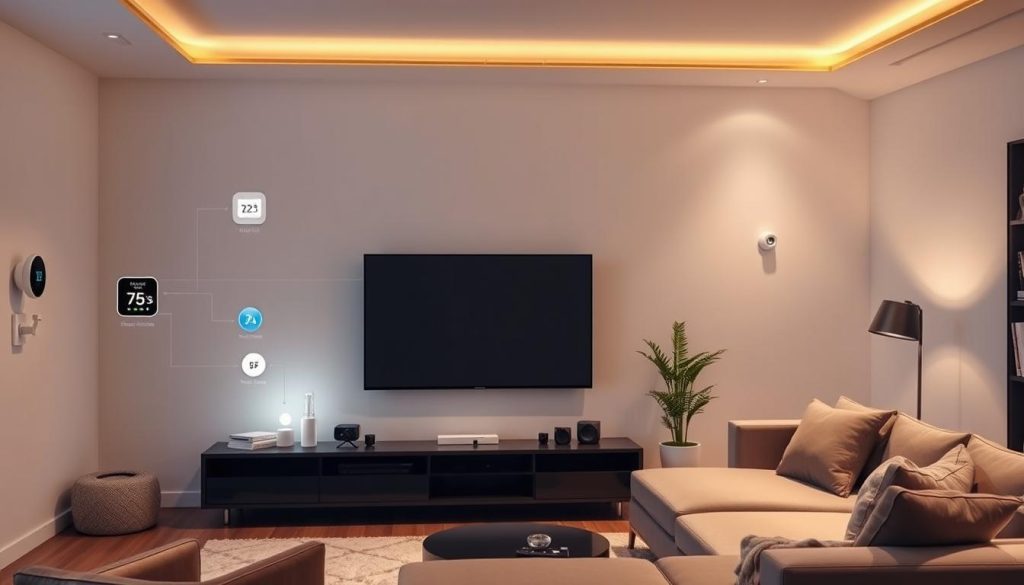
With your hub powered and cables sorted, you’re getting closer to enjoying smart home tech. Next, we’ll show you how to set up your hub on your network and connect your smart devices.
Setting Up the Hub on Your Network
To start using your smart home hub, you need to connect it to your network. This means linking it to Wi-Fi, setting up Ethernet, and fixing any connection problems. Smart home apps can help by offering clear instructions for setting up your home assistant.
When you connect to Wi-Fi, ensure you have a strong internet connection. Also, make sure your router works well with your smart home hub. A setup guide can guide you through this step.
Connecting to Wi-Fi
To link your smart home hub to Wi-Fi, just follow these steps:
- Open the smart home app on your device
- Select the Wi-Fi network you want to connect to
- Enter the password for your Wi-Fi network
Configuring Ethernet Connections
For a wired connection, you can set up Ethernet for your smart home hub. This can give you a more reliable connection and cut down on interference from other devices.
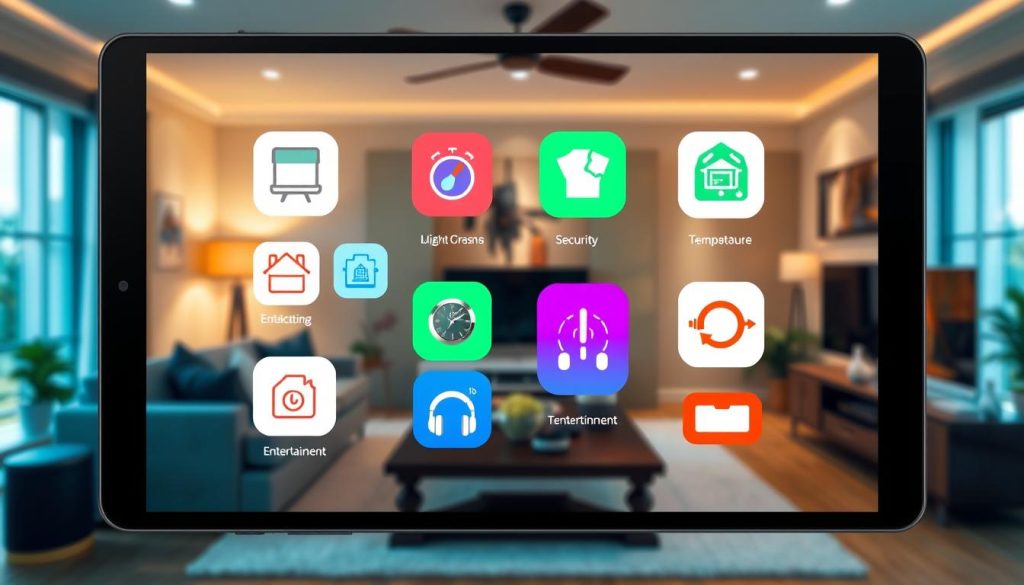
Troubleshooting Connection Issues
If you run into connection problems during setup, don’t worry. Most smart home apps have guides to help fix common issues. You can also check the user manual or reach out to the manufacturer’s support team for help.
| Connection Issue | Troubleshooting Step |
|---|---|
| Weak Wi-Fi signal | Move the router closer to the smart home hub |
| Ethernet connection not working | Check the Ethernet cable for damage or loose connections |
Adding Smart Devices to Your Hub
Now that your smart home hub is ready, it’s time to add smart devices. These devices make your life easier by letting you control them from anywhere. This way, you can manage your home with just a few taps on your phone.
There are many smart devices you can add, like lights, thermostats, security cameras, and door locks. Here are some examples:
- Smart light bulbs that can be controlled remotely
- Smart thermostats that can learn your temperature preferences
- Smart security cameras that can send alerts to your phone
- Smart door locks that can be controlled with a mobile app
Step-by-Step Pairing Instructions
To add a device, follow the pairing instructions from the manufacturer. This usually means putting the device in pairing mode. Then, select it from your hub’s list of available devices.
Managing Device Compatibility
Before adding a device, check if it works with your hub. You can find this info on the manufacturer’s website or by contacting their customer support.
By following these steps and choosing the right devices, you can create a smart home system. It will make your life easier and more convenient.
Customizing Settings and Preferences
To get the most out of your smart home hub, you need to customize its settings. This means setting up voice control, scheduling automations, and optimizing performance. Doing this makes your smart home fit your unique needs and preferences.
Voice control setup is a convenient feature of smart home hubs. You can use Alexa or Google Assistant to control devices with your voice. This is handy when your hands are full or you’re in another room. Just follow the manufacturer’s instructions to link your virtual assistant to your hub.
Setting Up Voice Control Features
You can also schedule automations to make life easier. For instance, lights can turn on when you enter a room. Or, your thermostat can adjust the temperature at specific times. This saves time, energy, and money on utility bills.
Scheduling Automations
Optimizing your smart home hub’s performance is key. Make sure it’s connected to a stable internet and all devices are compatible. This ensures a seamless smart home experience. With smart home integration, you can control everything from one place, making it easy to manage your home.
Optimizing Performance
Some popular smart home integration options include:
- Controlling your lights and thermostat with a single app
- Receiving notifications when someone enters or leaves your home
- Adjusting your home’s security settings with just your voice
Customizing your smart home hub unlocks a world of convenience. With voice control and smart home integration, you can enjoy a more comfortable and connected living experience.
Maintaining Your Smart Home Hub
To keep your smart home tech working well, you need to maintain your hub. This means updating software, fixing common problems, and keeping devices safe. Doing this helps your internet of things devices work better and longer.
Regular upkeep is key to avoid problems and keep your hub current. Here are important tasks for your maintenance routine:
- Regular software updates to ensure you have the latest features and security patches
- Troubleshooting common issues, such as connectivity problems or device compatibility issues
- Keeping your devices secure by changing passwords and enabling two-factor authentication
By following these steps, you’ll enjoy smart home tech and IoT devices more. You’ll also reduce the chance of problems and security threats.
Regular Software Updates
Regular software updates are vital. They keep your smart home hub current with new features and security fixes. This prevents issues and keeps devices working together smoothly.
Troubleshooting Common Issues
Fixing common problems is crucial. It stops downtime and keeps your smart home tech running right.
Keeping Your Devices Secure
Securing your devices is essential to avoid breaches and protect your data. This includes changing passwords, using two-factor authentication, and keeping software up to date.
Exploring Advanced Features and Integrations
Now that you’ve set up your smart home hub and connected your devices, it’s time to dive into advanced features. You can create customroutines and scenes to automate your daily tasks. For example, you can program your hub to turn on the lights, adjust the thermostat, and even start your morning coffee with just a voice command or a tap on your phone.
You can also enhance your smart home by integrating it with variousthird-party apps and services. This includes smart home assistants like Amazon Alexa or Google Assistant, home security systems, and energy management tools. By using these integrations, you can control and monitor your entire smart home from one place.
As you expand your smart home, make sure tofuture-proof your setup. Choose a smart home hub that gets regular software updates and can add new devices and features over time. This way, your smart home will keep growing and adapting to new home automation technology.

